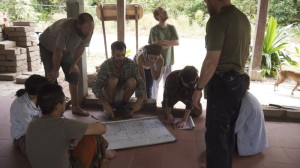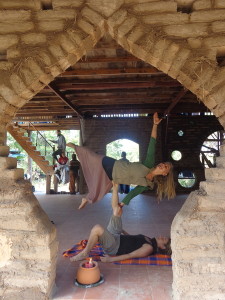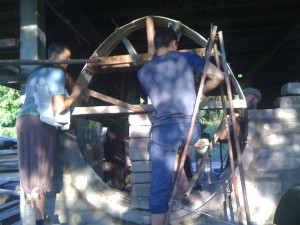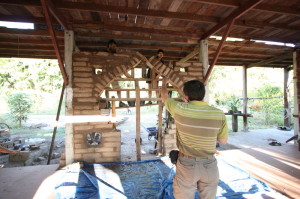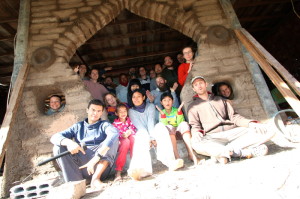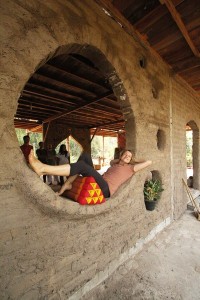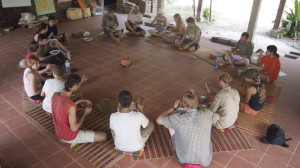Spreading the Seeds of change…

The unique organization of Surplus Permaculture Design allows us to offer a wide range of services. We have designers based on 3 continents and are now happy and excited to welcome Lola Byron and Kyle Smith to the our design team. Helping us spread the seeds of change and create planetary regeneration through thoughtful ecological design and individual empowerment.
Since 2013 Lola has been the natural building manager and Kyle the perennial plant manger at Panya Project Permaculture Education Centre in Northern Thailand . Both were long-term community members facilitating Permaculture design courses, organic gardening and natural building workshops, supervising volunteers and interns and developing and maintaining projects and systems at Panya. They also took responsibility of the book keeping, emails, marketing and admin for Panya
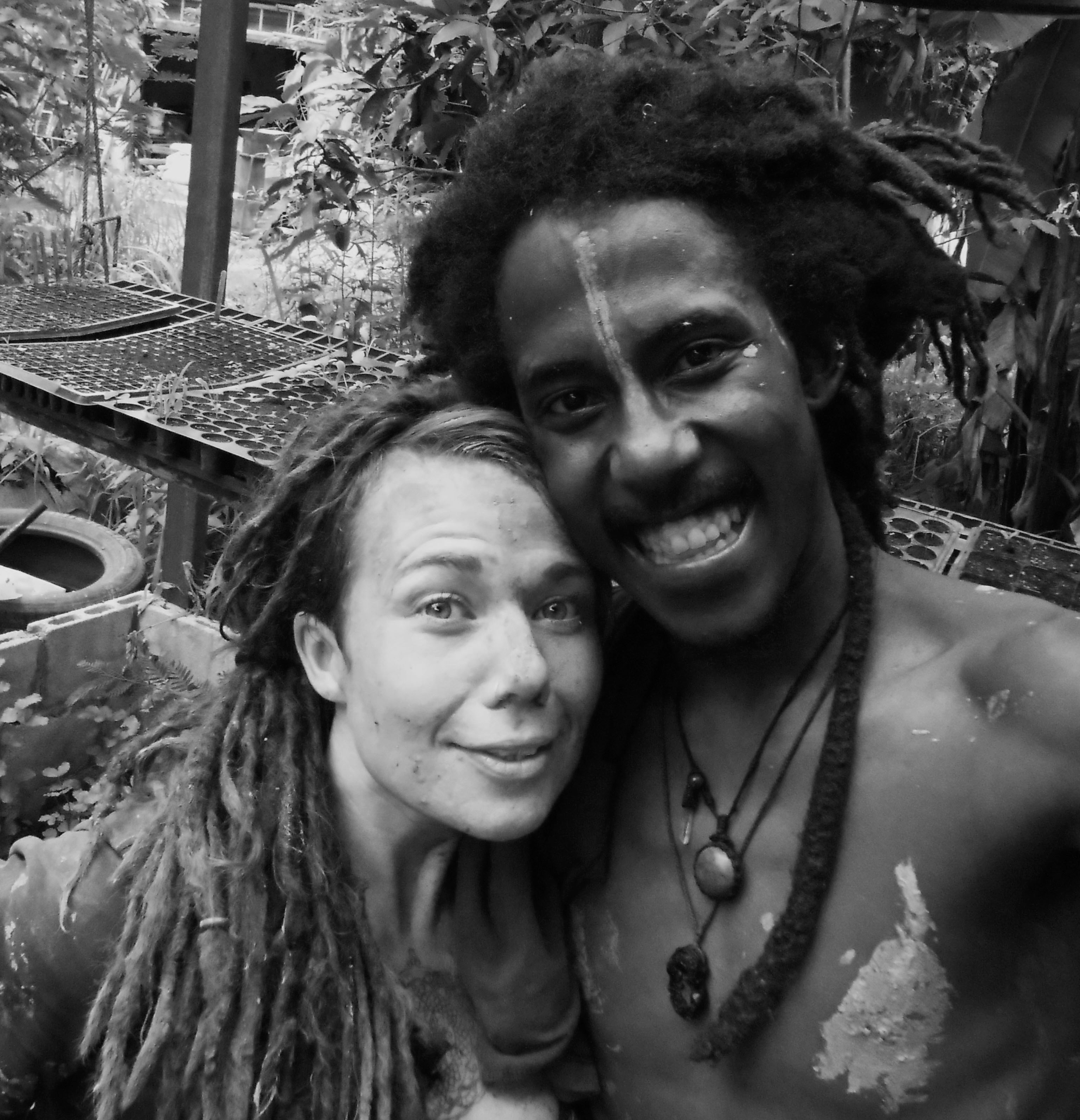
Lola Byron has been a thriving Permaculturist and natural builder since completing her PDC in Bristol, England in 2010. She became extremely passionate about creating positive change within urban environments, seeing the unmet needs of the people, the huge amount of underutilised resources and so many people who were searching for a more earth conscious and people conscious way to live. She helped create a variety of community gardens, became an avid city forger and helped facilitate natural building and gardening workshops. Lola’s educational background was in Art, sculpting, spending 5 years studying to qualify as a college art teacher in 2007. Lola specialised in Sculpting with wood, clay and metal and she loves to apply these artistic skills to her work. When she first encountered natural building in 2009 she knew she had found her true path and set out to learn as much as she could and create beautiful buildings from earth. She now specialises in adobe, cob and earth-bags. Having now completed 6 house builds (project managing 4 of these) she is always excited to pass on her knowledge and inspire and empower others to re-connect with the earth, make positive changes and become more self-reliant.

Kyle Smith is originally from Swaziland, Africa. In 2005 Kyle practiced horticulture and community living on a kibbutz in Israel where he was inspired to pursue a career in horticulture. During his studies he completed an internship at Soil for Life, a Cape Town, South Africa based non-profit organization teaching people how to build the soil and grow healthy plants using organic and low-cost methods. After completing his studies in horticulture he worked at Kirstenbosch Botanical gardens in Cape Town. His main focuses were conserving indigenous plant species, rehabilitating degraded ecosystems, designing and establishing education gardens on the grounds of the botanic garden. During this time at the botanical gardens he realized the importance of conserving natural ecosystem while providing basic human needs, this interest and learning pathway lead him to the Panya Project. Kyle is passionate about conserving soil ecosystems, plant propagation and small-scale ecological agriculture. He is working towards empowering people to grow their own food, become more self reliant, and regenerate degraded ecosystem.

Lola and Kyle met at Panya and fell in love, they went on to create a beautiful family when their baby girl Lili was born in 2014. Their shared vision is to create an ecologically sound world, where we all live in harmony with the Earth and each other, using and promoting natural building, regenerative agriculture and community building techniques to achieve this.
In July 2016 they left Panya Project to embark on an adventure; visiting, contributing and learning from different Permaculture Projects in Africa, Europe and the UK. They are currently at 1B4 PermaPackers near Darnall South Africa helping develop a volunteer program, building a double chamber cob oven, implementing a food forest and developing the kitchen gardens. They plan to achieve their vision by running courses, consultation work, project implementation and management.

Are you interested in transforming your land into a natural sanctuary of abundance providing you with nutritious organic produce?
Have you dreamt about a ecological sound handcrafted house for you and your family?
Would you like to entertain friends in your unique outdoor cooking area; pizza oven, cob bench or fire pit? If interested in any of our services please send us a detailed email with how we may be of help.
Aim of ‘food forests’ is to provide food, fodder, pharmaceuticals, fiber and fun
Please check out this great article by David Quick about Food Forests, and the work Nick Tittle is promoting in Charleston, South Carolina.
David Quick
May 2 2015
Imagine planting a pecan or hickory tree instead of a magnolia, and orange, lemon or banana trees instead of crepe myrtles and oleanders, and blueberry and blackberry bushes instead of Japanese pittosporum shrubs, and strawberries and other food-bearing ground covers instead of lawn grass.
If homeowners and other property owners did this, in patterns similar to a forest, yards, school grounds and parks would be filled with such an abundance of free, local and fresh food that supermarket produce aisles, featuring produce grown thousands of miles away, could become virtually obsolete.
As people understand the importance of eating locally produced foods, the idea of “food forests” is spreading across the world, the nation and South Carolina. Food forests, aka forest gardens, are popping up in public spaces in the United States in cities ranging from Seattle to Tulsa, Okla.
Nature’s ecosystem
In a nutshell, creating a food forest involves mimicking nature’s climax ecosystem — the multi-layered forest, with its canopy, understory, vines, ground cover and fertile soil and root system below — with plants that provide food primarily for humans and other animals.
“It’s not gardening in the forest,” says Nick Tittle, the farm manager for the nonprofit Fresh Future Farm in the Chicora neighborhood in North Charleston. “It’s gardening like the forest.”
“(Creating a food forest) is taking the patterns and relationships of how nature works and applying human-centric plants to that: putting in food crops. We often say the yields of a food forest are food, fodder, fiber and pharmaceuticals. It’s literally everything you need out of a one living system.”
Germaine Jenkins, founder and director of Fresh Future Farm, added another “f” to that list: “And it’s fun!”
Jenkins and Tittle have created a food forest around the perimeter of the urban farm, which is less than an acre, that includes pecan, hazelnut, citrus, apple, pear, fig, banana, persimmon and plum trees, along with bamboo, muscadine, blueberries, blackberries and other lower-growing, perennial herbs and fruiting vines.
“People know rows,” says Jenkins, referring to planting annual food plants in rows, “but they don’t know about mixing different bunch of polycultures (using and mixing multiple crops in the same space) together. This is a way to demonstrate a food forest. Once you land on the property, this is the first thing you see.”
Movement spreading
Creating perennial food forests is a cornerstone of the growing permaculture movement in the United States.
That movement is taking root in the Lowcountry, where 17 people recently passed a 12-day course (taught by Tittle) and received the first-known permaculture certifications granted in the state. The Charleston Permaculture Guild also meets on a regular basis.
Next weekend, permaculture expert and author Wayne Weiseman will be in Charleston for a free lecture at 7 p.m. Friday at the Medical University of South Carolina’s Baruch Auditorium, 284 Calhoun St., and for a two-day “Forest Gardening & Permaculture Design Workshop” at the College of Charleston. The latter, which cost $120, takes place 9 a.m.-5:30 p.m. Saturday and Sunday.
Weiseman, who was certified in permaculture in 1999, is the co-author of “Integrated Forest Gardening: The Complete Guide to Polycultures and Plant Guilds in Permaculture Systems” and can attest to the increase in interest in permaculture and food forests in recent years.
“There’s been a very large uptick in interest. People knew about it in the Northeast, Northwest and California, but in the last seven years, it’s picked up in the Southeast and Midwest, too,” says Weiseman.
He says the increase in interest comes at the same time as people’s interest in the quality of food dovetails with concerns about the environment. Increased access to information via the Internet and social media, he adds, is adding to that awareness.
Weiseman knows first-hand the benefits of a food forests. He claims to get 80 percent of the food he needs for his family, including his wife and daughter, from his yard that lies on a mere one-sixth of an acre in Carbondale, Ill. On it, he has 250 species of plants. During the winter, he grows some food indoors.
And, he adds, it’s not a lot of work, due largely to the perennial nature and design of food forests and permaculture.
“I spend about eight days a year (working) in my garden,” he says. “It’s not a lot of work because it’s all about fertility and diversity of plants.”
Post and Courier, David Quick
Reach David Quick at 937-5516 or dquick@postandcourier.com
Photos
Learn more about food forests
Wayne Weiseman, author of “Integrated Forest Gardening: The Complete Guide to Polycultures and Plant Guilds in Permaculture Systems,” will be in Charleston next weekend for a free talk and a two-day intensive workshop.
Weiseman is certified by the American Institute of Architecture and the American Society of Landscape Architects to teach continuing education in permaculture to licensed architects and landscape architects.
At 7 p.m. Friday, he will give a talk and sign books at the Medical University of South Carolina’s Baruch Auditorium, 284 Calhoun St.
The two-day workshop, which costs $120 (includes lunch and materials), will be 9 a.m. to 5:30 p.m. Saturday and May 10 at the College of Charleston’s School of Science Building, Room 138, 202 Calhoun St.
To register, go towww.surpluspermaculture.org/2-day-forest-gardening/
Natural building and self empowerment in Nong Khai, Northern Thailand

This passed month of January, it was offered a great opportunity of collaboration between surplus design and the Gaia ashram in Northern Thailand. Geoffroy, went as the surplus representative, to co- facilitate this two week natural building and self empowerment workshop. Alongside Om and Tom, the founders of the Gaia ashram and respectively eco-village design and deep ecology facilitators, the team brought the level pretty high, with lots of fun and lots of sharing of knowledge and experience.
14 participants coming from 9 different countries came to experience a different lifestyle, with more connections with our natural enviroment, more connections with each others and more connections with ourselves.
Through group activities and self directed sessions, the participants got to :
-design their building projects
– harvest all the building materials on site
– build
Within two weeks we achieved the construction of three walls with extremly high technical levels in term of design choices. We have achieved with great success to defy the law of gravity with ancient knwoledge on arch making. Some of the main key outcomes on a practical level were :
-adobe bricks making
-brick laying
-natural arch making (including carpentry for building the arch form)
-cob making and using
-lintel inserting
-bottle bricks making
– wattle and cob making
– plastering
We also worked on our personal life project, understanding of holistic goals management, understanding of the different personality types, checking in with our emotional state, tackling with the importance of compassionate communication in our daily lifes.
A great internship, with the start of some great friendships, lead us to already fix the dates for the next internship of the same kind, with the same team of facilitators at the same place next year.
Fresh Future Farm in the news
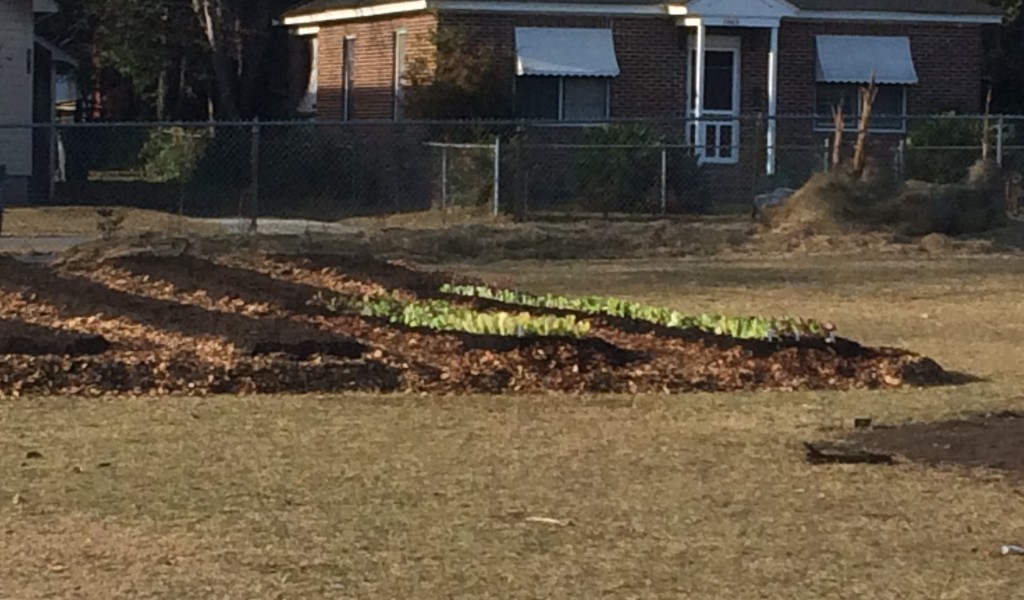
Check out this great article on Fresh Future Farm and what Germain Jenkins and Nick Tittle are doing in Charleston South Carolina. Please come out and support our event on January 24 from 12-4 p.m at Holy City Brewing (4155C Dorchester Road).
Germaine Jenkins has created an inner-city farm and store, now she just needs a van to get people there
How Does Her Garden Grow?
By Kinsey Gidick of Charleston City Paper
When Germaine Jenkins talks about food deserts, she's doesn't recite USDA reports. She speaks from experience. "I found out the hard way that home ownership does not equal self-sufficiency," she says. "When I was living in public housing downtown next to Johnson & Wales, schools and grocery stores were right there. But you move to a less developed neighborhood, as I did in North Charleston, and all the stuff we need is outside the neighborhood. It makes no economic sense when I plan to live in this neighborhood as a long-term resident."
What Jenkins is talking about is the current situation facing 19,500 North Charleston residents who, as Paul Bowers reported in his 2011 story Unbalanced Diet, live in an area where picking up even basic food items involves often expensive long treks. In fact, North Charleston contains 11 census tracts that fit the criteria for food desert — an area where 20 percent live in poverty and are more than one mile from a supermarket or large grocery store. But Jenkins is committed to changing that with Fresh Future Farm, a fully functioning urban garden and grocery in Chicora-Cherokee.
As it stands now, Fresh Future Farm is on the brink of becoming a reality. It just needs one more component to be fully functional — a van to transport area shoppers without vehicles to and from the farm and store. With the help of a fundraiser with Holy City Brewing on Sun. Jan. 24, Jenkins hopes to raise the money to get it.
Sowing a Dream
At 2008 Success St., on a plot behind the old Chicora Elementary sits Fresh Future Farm. The idea is to provide locals with fresh produce grown in their own neighborhood. "Growing up, my mom had food stamps, but she also had a circle of friends and support system, so we were able to make it," Jenkins says of her childhood in Cleveland, Ohio. But it was a different story when Jenkins moved to Charleston and started attending Johnson & Wales for baking and food service management. "I didn't have that kind of support here," she says.
Even though Jenkins found housing in the projects next to the culinary school, her classes were in the afternoon until late at night, leaving her no time to work a job while caring for her two young children. In trying to make it on her own, she says she got to experience being broke first hand. "But I was determined that we would one day own our own house and learn to grow our own food," she says.
Jenkins began volunteering at the Lowcountry Food Banks' Kids Cafe. There her children got the full meals she couldn't provide and, in exchange, she began to learn more about nutrition. Jenkins used the opportunity to teach the kids about vegetables. "I started with stuff that the kids were eating, hiding vegetables everywhere I could," she says. "Then I'd say, 'You can earn a prize for guessing all the veggies in the spaghetti sauce.'"
LFB's former director Jermaine Husser saw Jenkins leading a Kids Cafe class and was impressed. He quickly offered her a position with the organization. Then Jenkins got involved with Metanoia, a nonprofit community development organization in the Chicora-Cherokee neighborhood. While serving on the board of Metanoia she says, "I learned the best practices of how other neighborhoods are able to revitalize and have done so using food as the vehicle for development."
Those plans might just be realized with Fresh Future Farm. On a 0.81 acre plot, master gardener Jenkins, along with permaculture expert Nick Tittle and strategic development consultant Todd Chas, have built the start of the garden. The ultimate goal is to have it fully planted by spring with blackberry bushes, apple, citrus, pear, and pecan trees, raised beds with lettuces, and chicken and duck coops. In the center will be a classroom to teach neighbors and volunteers growing techniques, like how to plant the bottoms of used root vegetables back into the soil for a second crop. When they open next month, the first available produce will be collards grown on the farm.
Destination: Healthy Food
But the biggest problem facing North Charleston shoppers continues to be distance to fresh food. Save-A-Lot, which opened in 2010 at Rivers and Durant avenues, serves the Northern region of the North Charleston community, but it's still a 2.4 mile hike from the farm, where Fresh Future Farm is located. And while the Beach Company's proposed 217 unit apartment Garco Factory promises to build a grocery should enough tenets commit to the building, that won't happen until 2016 at the earliest and will also be a 2.7 miles from Chicora Cherokee — a long ways for residents using taxis, the bus, bikes, or, in many cases, simply on foot.
"At the beginning of each month when people get their food stamps, taxis start lining up around this neighborhood. But that's not a way to build wealth," says Jenkins. Instead, she hopes the van, which will give a free ride to Fresh Future Farm to any person without transportation within a two-mile radius who promises to spend at least $50, will help. "We'll accept SNAP on day one," Jenkins says. "The average income might be $1,200 for EBT, but this neighborhood spends $4 million on groceries each year. Park Circle spends $5 million. For people who don't have regular transportation, this is where you can come."
To help Fresh Future Farm raise the money for their van, attend the Vantastic Fundraiser on Sat. Jan. 24 from 12-4 p.m at Holy City Brewing (4155C Dorchester Road). Chef B.J. Dennis will be preparing meat and three plates with a choice of roasted pig, chimichurri pasta salad, collard greens, chicken rice, vegetarian soup bunch, and sweet potato bread (or 3 vegetarian sides) for a suggested donation of $8 a plate.
To see the orginial article: http://www.charlestoncitypaper.com/charleston/germaine-jenkins-has-created-an-inner-city-farm-and-store-now-she-just-needs-a-van-to-get-people-there/Content?oid=5066695
Roundwood Strawbale house in the Belgian Ardennes
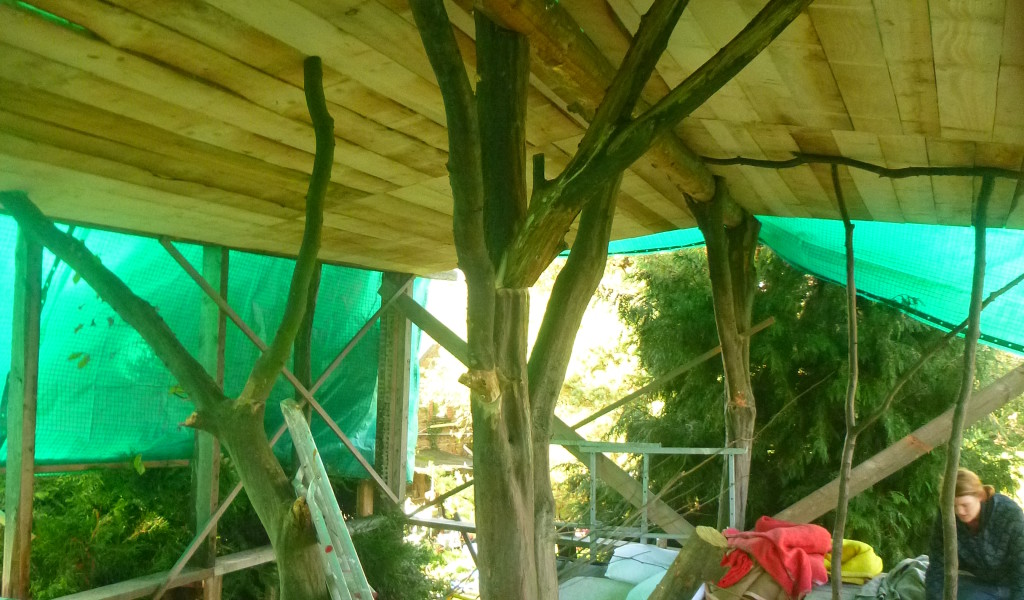
In the autumn of 2014, Surplus members Brecht and Geoffroy were building a strawbale house in the Ardennes of Belgium. Both bold and creative in its design, it uses almost purely reclaimed and natural materials.
 surpluspermaculturedesign
surpluspermaculturedesign




